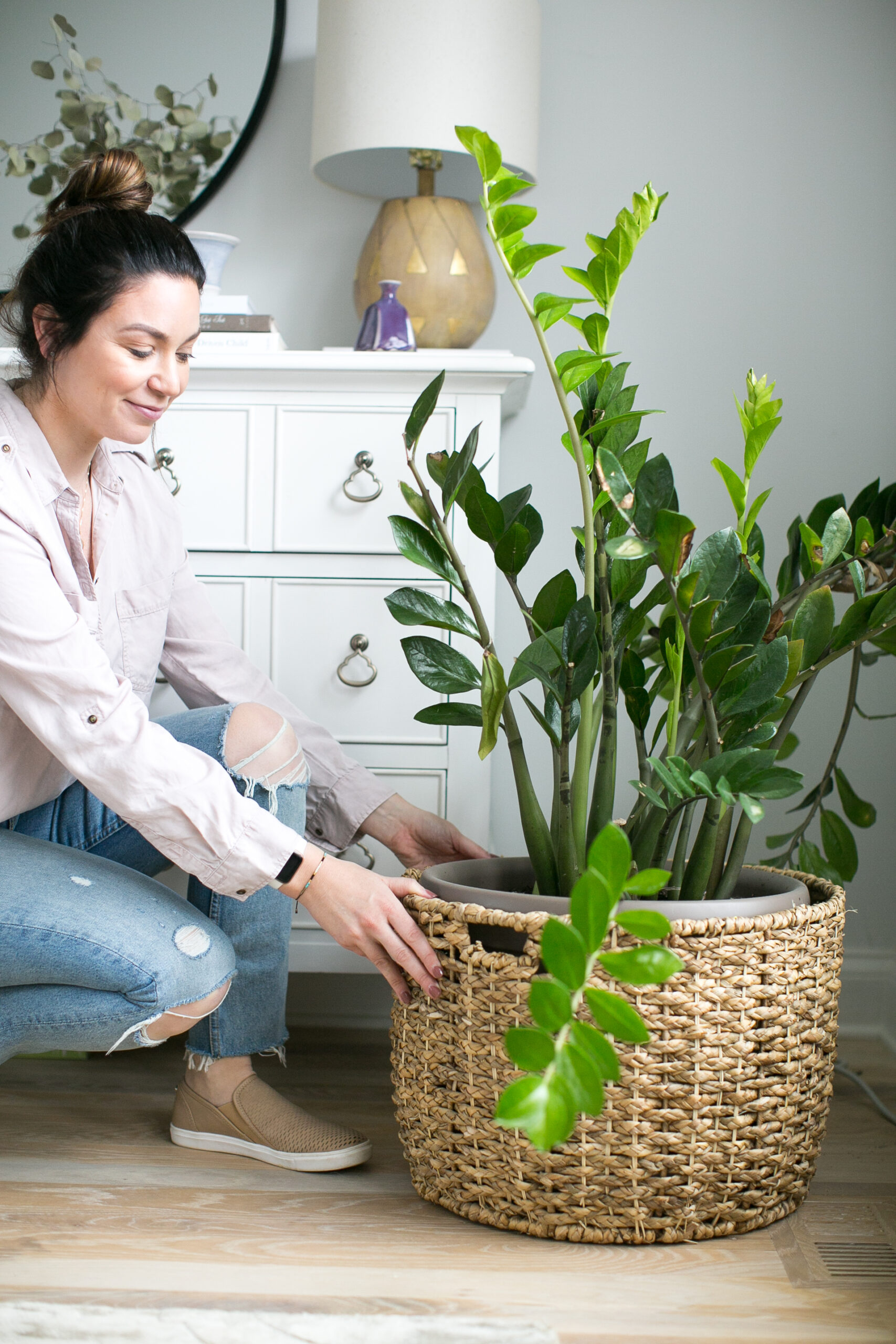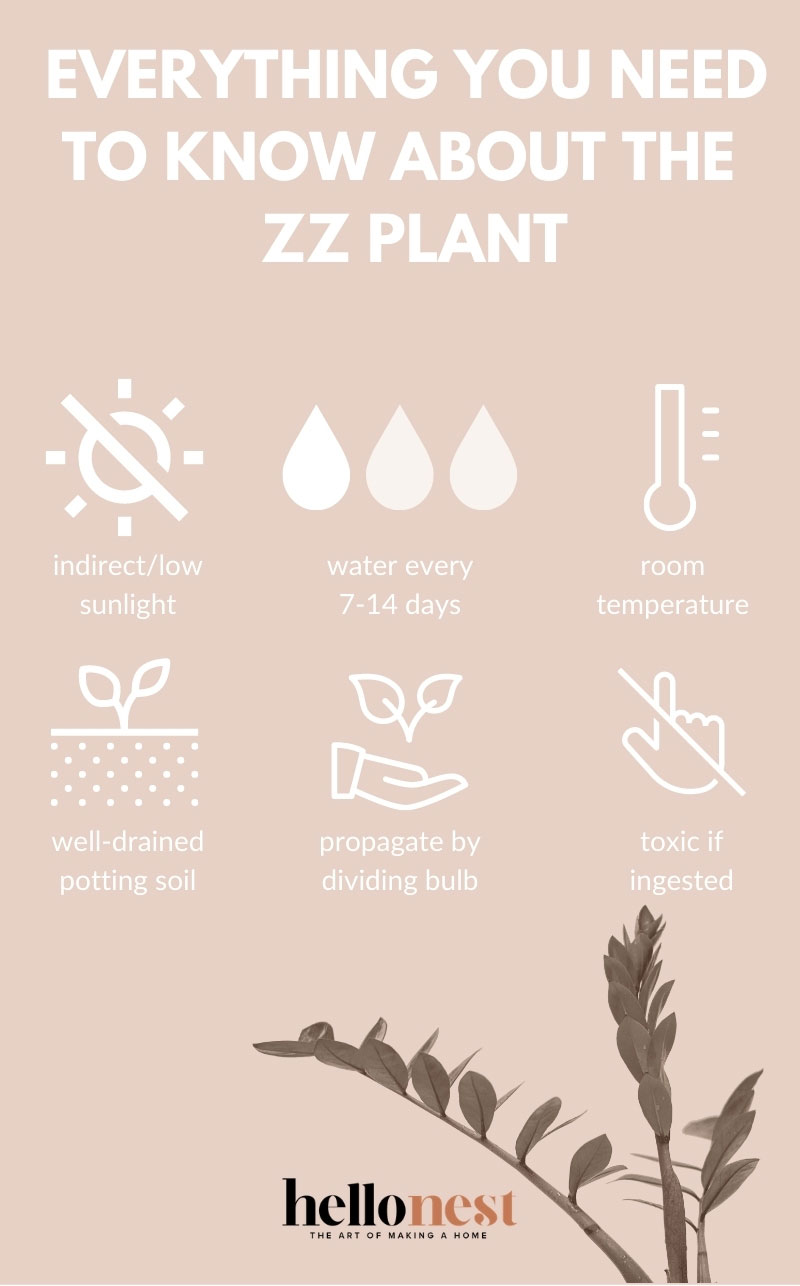If we had to pick one houseplant that seems to fit perfectly at the intersection of low maintenance and high impact, it would be the interior design favorite Zamioculas Zamiifolia, or the ZZ plant. A tropical perennial native to eastern Africa, this sturdy succulent is a must-have for anyone who struggles with a green thumb but is looking for a robust plant to energize their space.

Once you’ve got your hands on a ZZ, here’s how to care for it:
Light
While the ZZ plant would do best in a bright, open space with indirect sunlight, these plants are often seen in offices and malls, because they can handle very low levels of natural light. In a home, your plant would be happiest in any room with a window.
However, its low-light resilience makes it a great choice for greening up hallways, bathrooms, or any other windowless room you may have. If you do choose to set your plant near a window, be sure it’s kept out of direct sunlight or it could burn.
Water and food
The easiest way to kill your ZZ plant is to overwater it. If you see the leaves yellow and drop, this could be a sign that too much water is your problem. Allow the soil to dry down at least 2-4 inches before watering (this plant can handle completely dry soil before watering).
You may need to irrigate a bit more frequently if you notice it starting to drop otherwise healthy leaves. Remember that this is a succulent, so the leaves are thick and robust because they are very good at holding on to water.
The bulbous rhizomes located in the roots also hold on to water and are prone to rot if you give them too much. Every few weeks or as needed, give your plant a thorough drink, and then allow it to drain completely before setting it back into its tray. Use a general house plant fertilizer to feed once a month when watering during the summer months.
Temperature and humidity
Average room temperature will be just fine for your ZZ plant, as will high humidity and heat. In cooler months, you’ll want to be sure your plant is kept warmer than 60 degrees or the cold will stunt its growth. Set it away from drafty windows (and air conditioning units in the summer), as well as heaters and radiators.
If your home is dry, lightly mist your plant regularly, or situate your plant on a pebble tray filled with water, so your plant can reap the benefit of the evaporated moisture without its roots rotting in a pool of water.
Soil/Potting
Your plant may be root bound and needing to move up a pot size if you notice stunted growth, leaves browning or wilting, or soil that seems to dry out very quickly. You might also notice roots coming out the bottom of the pot. Before transplanting (ideally in the spring), give your plant a good watering, gently tip the plant upside down and slide the root ball out. Remove as much of the old soil as possible, and untangle the roots with your fingers.
Choose a pot the next size up, add fresh, moist, well-draining potting soil in a layer at the bottom, place plant in, and spread roots around. Fill in with additional soil to the top of the pot, and give another thorough watering. ZZ plants should be in clay pots so excess moisture can slowly evaporate evenly.
Propagating
You can easily divide your ZZ plant into smaller plants with a bit of propagation know-how. Gently remove your plant from its pot, and clean off soil so you are able to clearly see the roots and rhizomes (the tuber-like bulbs in the roots.) Find a bulb that has both roots and stems growing out of it, and gently remove. Plant according to the instructions above.
Toxicity/filtration of toxins
Similar to the philodendron, a relative of the ZZ plant, it’s worth noting that this plant is considered toxic when ingested, causing stomach pain or gastric distress. Keep the plant away from small children and curious pets, and wash your hands if you touch any sap while handling.
But here’s why you’ll still want to get one: a 1994 study out of the University of Copenhagen showed that while this plant may upset the stomach when eaten, it’s great for the lungs: the ZZ plant effectively filters volatile pollutants such as benzene, toluene, ethylbenzene and zylene (common chemicals released from carpets, furniture, and finishes) from indoor air.
Strong and structured enough to have what it takes to become a focal point, but low-maintenance enough to survive with the most minimal attention and care, the ZZ plant is for anyone out there who thinks they just don’t have what it takes to become a plant owner. You just may have found your dream green!
9
Leave a Reply